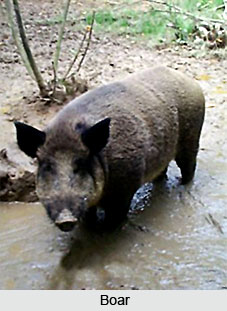 The Indian Boar, known by the scientific name Sus scrofa cristatus, is commonly known as the Moupin pig. It is a subspecies of wild boar indigenous to the Indian subcontinent. Distinguishing characteristics of the Indian boar include its prominent mane, which forms a crest along its back from the head to the lower body, a larger and more sharply featured skull compared to other wild boar subspecies, smaller and sharper ears, and a lighter build. The Indian boar is found in various habitats across the country. While it can be seen amidst human settlement, the wild boar in India is counted among the significant wildlife species.
The Indian Boar, known by the scientific name Sus scrofa cristatus, is commonly known as the Moupin pig. It is a subspecies of wild boar indigenous to the Indian subcontinent. Distinguishing characteristics of the Indian boar include its prominent mane, which forms a crest along its back from the head to the lower body, a larger and more sharply featured skull compared to other wild boar subspecies, smaller and sharper ears, and a lighter build. The Indian boar is found in various habitats across the country. While it can be seen amidst human settlement, the wild boar in India is counted among the significant wildlife species.
Physical Characteristics of Indian Boar
The Indian Boar stands taller and is more sparsely haired than the European wild boar, though its back bristles are significantly more developed. The tail of the Indian boar is also more tufted, and its cheeks are hairier. Adults typically range in shoulder height from 83.8 to 91.4 cm, with some specimens, such as one found in West Bengal, reaching up to 38 inches. They can measure up to five feet in body length and weigh between 90.7 and 136.1 kg.
Significance of Boar in Indian Culture
The Indian Boar holds historical significance in Indian culture, having interacted with humans since the Upper Paleolithic period. The earliest depiction of the boar in Indian art dates back to cave paintings found in the Bhimbetaka rock shelters. In Hindu mythology, the boar features in various stories. One such story from the Brahmanas recounts Indra slaying an evil boar that had stolen the treasure of the asuras. Indra then offers the carcass to Vishnu, who sacrifices it to the gods and goddesses for consumption. In another tale from the Charaka Samhita, a boar named Ermusha is described as an avatar of Brahma, who raises the earth and sky from the primeval waters of the universe during creation. The Ramayana, Mahabharata, and the Puranas also mention Varaha, another boar avatar of Vishnu, who slays the demon Hiranyaksha to save Bhumi (Mother Earth).



















